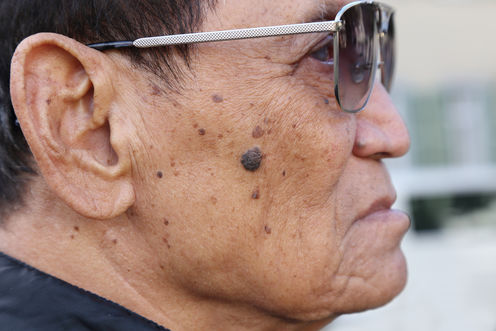
Australia has one of the highest rates of skin cancer in the world. Two-thirds of Australians will be diagnosed with skin cancer by the age 70.
The vast majority are non-melanoma skin cancers such as squamous cell carcinomas (SCC) and basal cell carcinomas (BCC). These are relatively easy to treat and rarely spread to other parts of the body.
Thirty years of SunSmart campaigns have raised community awareness – and anxiety – about skin cancer. But while most people know early detection is best, there’s a lot of confusion about whether you need to undergo regular skin checks.
Breast, bowel and cervical cancer prevention programs recommend population-wide screening with mammograms, pap tests and stool tests. But this isn’t the case for skin cancer checks.
Opportunistic screening
Current clinical guidelines recommend examining your own skin and asking your GP for a skin check if you notice anything suspicious.
This means familiarising yourself with your skin and looking for new moles, sores, lumps or lesions – or those that have changed size, shape or colour.
Australian guidelines favour self-detection and opportunistic screening over a population-wide program of regular skin checks because such a program would be incredibly costly and there is insufficient evidence that checking everybody would save lives. This is because:
-
very few people die from non-melanoma skin cancer
-
while advanced melanoma is deadly, the frequency of melanoma in the community does not justify a mass population screening program on economic grounds
-
the instrument that would be used for mass screening (assessment by a general practitioner) is not sufficiently accurate – in other words, GPs may remove too many benign lesions and also fail to diagnose and remove the skin cancers.
What should you do if you find a suspicious spot?
If you find a suspicious spot on your skin, ask your GP for a skin check. Your family doctor knows you, your medical history, your family history and is your first point of call.
There are only three possible diagnoses your doctor can make for you skin lesion: clearly malignant, clearly benign and too close to call.
If your doctor is 100% sure the lesion is a skin cancer, they will arrange for it to be removed. Each GP knows the limits of their surgical skill and will refer you on to a dermatologist as necessary. If you’re particularly concerned about scarring, you can request a referral to a dermatologist or plastic surgeon.
If your doctor is 100% certain the lesion is benign, no treatment is required and you will be reassured. Your doctor will examine any other skin lesions and provide you with advice about sun protection and early diagnosis of skin cancer.
If after examining your skin lesion, your doctor is only 99% sure that the lesion is benign, then a definitive diagnosis is required. Options include diagnostic biopsy, excision biopsy or referral to a dermatologist.
Access to specialists varies and patients may have to wait weeks or months for a definitive diagnosis for a “suspicious lesion”. So GPs often excise lesions they feel are low (but not zero) risk.
Consequently, the number of benign lesions needed to be excised for every skin cancer removed is approximately 20 for melanoma and three for non-melanoma skin cancers.
Some dermatology centres provide rapid assessment clinics for GP-referred patients with suspicious lesions.
High-risk groups
People at higher risk of skin cancer may benefit from asking their doctor for a skin check.
Apart from facilitating early diagnosis, the skin check is an opportunity to discuss your individual risk, what to look for when examining your skin, and ways to protect yourself in the sun.
Medical photography is increasingly popular and there is some evidence to support its use in high-risk patients to help detect melanomas early.
But photographs are not the best way to detect non-melanoma skin cancers. Nor are they a substitute for an examination by an experienced clinician.
People who have had previous skin cancer should see their dermatologist once a year for a skin check.
Those who have had more than 20 solar keratosis (lesions caused by UV rays) treated should see a dermatologist for an initial assessment and then once every two to three years.
People with a first-degree relative who has had a melanoma should ask their GP for a skin check and to assess their risk.
Those with red hair, fair skin, blue eyes and those with lots of moles (more than 50) should consider a skin assessment once they hit 30.
People with blond hair, fair skin and blue eyes could wait until they are 40.
And the rest of us might consider having a check when we turn 50.
Further reading: Spot the difference: harmless mole or potential skin cancer
Prof Rod Sinclair is a senior Australian Dermatologist and is Director of Dermatology at the Epworth Hospital.
